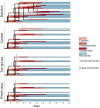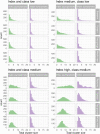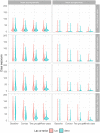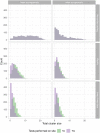COVID-19 in schools: Mitigating classroom clusters in the context of variable transmission
- PMID: 34237051
- PMCID: PMC8266060
- DOI: 10.1371/journal.pcbi.1009120
COVID-19 in schools: Mitigating classroom clusters in the context of variable transmission
Abstract
Widespread school closures occurred during the COVID-19 pandemic. Because closures are costly and damaging, many jurisdictions have since reopened schools with control measures in place. Early evidence indicated that schools were low risk and children were unlikely to be very infectious, but it is becoming clear that children and youth can acquire and transmit COVID-19 in school settings and that transmission clusters and outbreaks can be large. We describe the contrasting literature on school transmission, and argue that the apparent discrepancy can be reconciled by heterogeneity, or "overdispersion" in transmission, with many exposures yielding little to no risk of onward transmission, but some unfortunate exposures causing sizeable onward transmission. In addition, respiratory viral loads are as high in children and youth as in adults, pre- and asymptomatic transmission occur, and the possibility of aerosol transmission has been established. We use a stochastic individual-based model to find the implications of these combined observations for cluster sizes and control measures. We consider both individual and environment/activity contributions to the transmission rate, as both are known to contribute to variability in transmission. We find that even small heterogeneities in these contributions result in highly variable transmission cluster sizes in the classroom setting, with clusters ranging from 1 to 20 individuals in a class of 25. None of the mitigation protocols we modeled, initiated by a positive test in a symptomatic individual, are able to prevent large transmission clusters unless the transmission rate is low (in which case large clusters do not occur in any case). Among the measures we modeled, only rapid universal monitoring (for example by regular, onsite, pooled testing) accomplished this prevention. We suggest approaches and the rationale for mitigating these larger clusters, even if they are expected to be rare.
Conflict of interest statement
The authors have declared that no competing interests exist.
Figures






References
-
- CDC. COVID-19 in Children and Teens; 2020. https://www.cdc.gov/coronavirus/2019-ncov/daily-life-coping/children/sym....
-
- Johns Hopkins University. Coronavirus Resource Center; 2020. https://coronavirus.jhu.edu/.
-
- European Centre for Disease Prevention and Control. COVID-19 in children and the role of school settings in COVID-19 transmission; 2020. https://www.ecdc.europa.eu/en/publications-data/children-and-school-sett....
-
- ENOC-UNICEF Report on Ombudspersons and Commissioners for Children’s Challenges and Responses to COVID-19;. https://enoc.eu/?p=3515.
Publication types
MeSH terms
LinkOut - more resources
Full Text Sources
Medical

